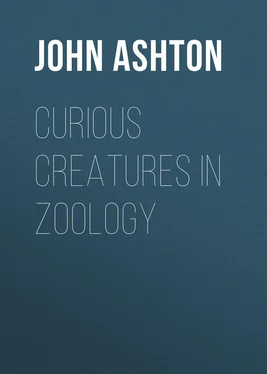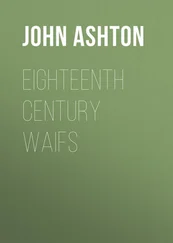John Ashton - Curious Creatures in Zoology
Здесь есть возможность читать онлайн «John Ashton - Curious Creatures in Zoology» — ознакомительный отрывок электронной книги совершенно бесплатно, а после прочтения отрывка купить полную версию. В некоторых случаях можно слушать аудио, скачать через торрент в формате fb2 и присутствует краткое содержание. Жанр: Природа и животные, foreign_antique, foreign_prose, на английском языке. Описание произведения, (предисловие) а так же отзывы посетителей доступны на портале библиотеки ЛибКат.
- Название:Curious Creatures in Zoology
- Автор:
- Жанр:
- Год:неизвестен
- ISBN:нет данных
- Рейтинг книги:4 / 5. Голосов: 1
-
Избранное:Добавить в избранное
- Отзывы:
-
Ваша оценка:
- 80
- 1
- 2
- 3
- 4
- 5
Curious Creatures in Zoology: краткое содержание, описание и аннотация
Предлагаем к чтению аннотацию, описание, краткое содержание или предисловие (зависит от того, что написал сам автор книги «Curious Creatures in Zoology»). Если вы не нашли необходимую информацию о книге — напишите в комментариях, мы постараемся отыскать её.
Curious Creatures in Zoology — читать онлайн ознакомительный отрывок
Ниже представлен текст книги, разбитый по страницам. Система сохранения места последней прочитанной страницы, позволяет с удобством читать онлайн бесплатно книгу «Curious Creatures in Zoology», без необходимости каждый раз заново искать на чём Вы остановились. Поставьте закладку, и сможете в любой момент перейти на страницу, на которой закончили чтение.
Интервал:
Закладка:
But it is reserved to Sir John Mandeville to have found the tallest giants of, comparatively speaking, modern times. “And beyond that valey is a great yle, where people as great as giaunts of xxviii fote long, and they have no clothinge but beasts skyns that hang on them, and they eate no bread, but flesh raw, and drink milke, and they have no houses, & they ate gladlyer fleshe of men, than other, & men saye to us that beyonde that yle is an yle where are greater giaunts as xlv or l fote long, & some said l cubits long ( 75 feet ) but I saw them not, and among those giaunts are great shepe, and they beare great wolle, these shepe have I sene many times.”
Early Men
On the antiquity of man it is impossible to speculate, because we have no data to go upon. We know that his earliest existence, of which we have any cognisance, must have been at a period when the climate and fauna of the Western continent was totally different to their present state. Then roamed over the land, the elephant, rhinoceros, hippopotamus, the Bos-primigenius, the reindeer, the cave bear, the brown and the Arctic bears, the cave hyæna, and many other animals now quite extinct. We know that man then existed, because we find his handiwork in the shape of manufactured flint implements, mixed with the bones of these animals – and, occasionally, with them human remains have been found, but, as yet, no perfect skull has been found. There were two types of man, the Dolicho Cephalous, or long-headed, and the Brachy Cephalous, or round-headed – and, of these, the long-headed were of far greater antiquity.
All we can do is to classify man’s habitation of this earth, as well as we can, under certain well-defined, and known conditions. Thus, that called the Stone Age, must be divided into two parts, that of the roughly chipped flint implements – which is designated the Palæolithic period – and that of the polished and carefully finished stone arms and implements, which necessarily show a later time, and a higher state of civilisation – which is called the Neolithic period. The next age is that of bronze, when man had learned to smelt metals, and make moulds, showing a great advance – and, finally, the Iron Age, in which man had subdued the sterner metal to his will – and this age immediately precedes History.
The cave men were of undoubted antiquity – and were hunters of the wild beasts that then overran Western Europe, and who split the bones of those animals which they slew in order to obtain the marrow. Although strictly belonging to the Palæolithic period, they manufactured out of that stubborn material, flint, spear-heads, knives, scrapers – and, when the bow had been invented, arrow-heads. Nor were they deficient in the rudiments of art, as some tracings and carvings on pieces of the horns of slaughtered animals, clearly show. Mr. Christie in digging in the Dordogne caves found, at La Madelaine, engraved and carved pictures of reindeer, an ibex, a mammoth, &c., all of them recognisable, and the mammoth, a very good likeness. This was incised on a piece of mammoth tusk.
The lake men, judging by the remains found near their dwellings, occupied their houses during the Stone and Bronze periods. Herodotus mentions these curious dwellings. “But those around Mount Pangæus and near the Doberes, the Agrianæ, Odomanti, and those who inhabit Lake Prasias 22 22 A lake between Macedonia and Thrace.
itself, were not at all subdued by Megabazus. Yet he attempted to conquer those who live upon the lake, in dwellings contrived after this manner: planks, fitted on lofty piles, are placed in the middle of the lake, with a narrow entrance from the mainland by a single bridge. These piles that support the planks, all the citizens anciently placed there at the common charge; but, afterwards, they established a law to the following effect; whenever a man marries, for each wife he sinks three piles, bringing wood from a mountain called Orbelus; but every man has several wives. They live in the following manner; every man has a hut on the planks, in which he dwells, with a trap door closely fitted in the planks, and leading down to the lake. They tie the young children with a cord round the foot, fearing lest they should fall into the lake beneath. To their horses and beasts of burden they give fish for fodder; of which there is such an abundance, that, when a man has opened his trap-door, he lets down an empty basket by a cord into the lake, and, after waiting a short time, draws it up full of fish.” 23 23 The fishermen of lake Prasias still have lake dwellings as in the time of Herodotus.
Here, then, we have a valuable record of the lake dwellings, and similar ones have been found in the lake of Zurich. In 1854, owing to the dryness and cold of the preceding winter, the water fell a foot below any previous record: and, in a small bay between Ober Meilen and Dollikon, the inhabitants took advantage to reclaim the soil thus left, and add it to their gardens, by building a wall as far out as they could – and they raised the level of the land thus gained, by dredging the mud out of the lake. In the course of dredging they found deer horns, tiles and various implements, and, the attention of an antiquary having been directed to this find, he concluded that it was the site of an ancient lake village. The lakes of Geneva, Constance, and Neufchatel, have also yielded much that throws light on the habits and intelligence of these lake men. They wove, they made pottery, they grew and parched corn – nay they ground it, and made biscuits, they ate apples, raspberries, blackberries, strawberries, hazel and beech nuts, and peas. They evidently fed on cereals, fruit, fish, and the flesh of wild animals, for bones of the following animals have been found. Brown bear, badger, marten, pine marten, polecat, wolf, fox, wild cat, beaver, elk, urus, bison, stag, roe-deer, wild boar, marsh boar – whilst their domestic animals were the boar, horse, ox, goat, sheep, and dog. These, it must be remembered, range over a wide period, including the stone and bronze ages. They wore ornaments, too, for pins, and bracelets have been found. Lake dwellings have been found in Scotland, England, Italy, Germany and France – so that this practice seems to have obtained very widely. In Ireland they made artificial islands in the lakes, called Crannoges, on which they erected their dwellings. Pile dwellings now exist, and are inhabited in many parts of the world.
We have other traces of prehistoric man in the shell mounds, kjökkenmöddings, or kitchen middens, which still exist in Denmark, and have been found in Scotland on the shores of the Moray Firth and Loch Spynie; in Cornwall, and Devon, at St. Valéry at the mouth of the Somme, in Australia, Tierra del Fuego, the Malay Peninsula, the Andaman Islands, and North and South America, showing a very wide range. The Danish kjökkenmöddings, when first thoroughly noticed, (of course, in this century), were taken to be raised beaches – but when they were examined, it was found that the shells were of four species of molluscs or shell-fish, 24 24 The most abundant were the oyster, mussel, cockle, and periwinkle.
that did not live together, and that they were either full-grown, or nearly so. A stricter examination was made, and the result was the finding of some flint implements, and bones marked by knives, conclusively showing that man had had a hand in this collection of shells – and the conclusion was come to that these were the sites of villages of a prehistoric man, a hypothesis which was fully borne out by the discovery, in some of them, of hearths bearing traces of having borne fire. Thus, then, these refuse heaps were clearly the work of a very ancient race, so poor, and backward, as to be obliged to live on shell-fish – and these mounds were made by the shells which they threw away.
Интервал:
Закладка:
Похожие книги на «Curious Creatures in Zoology»
Представляем Вашему вниманию похожие книги на «Curious Creatures in Zoology» списком для выбора. Мы отобрали схожую по названию и смыслу литературу в надежде предоставить читателям больше вариантов отыскать новые, интересные, ещё непрочитанные произведения.
Обсуждение, отзывы о книге «Curious Creatures in Zoology» и просто собственные мнения читателей. Оставьте ваши комментарии, напишите, что Вы думаете о произведении, его смысле или главных героях. Укажите что конкретно понравилось, а что нет, и почему Вы так считаете.












